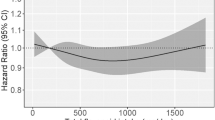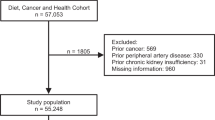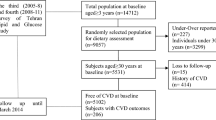Abstract
Objective:
To assess the relation between specific flavonoid classes and peripheral arterial occlusive disease (PAOD), an important manifestation of atherosclerosis.
Design:
Using data from a case–control study conducted in Greece in 1980 on the nutritional epidemiology of PAOD, we have exploited recently published databases on the content of foods in specific flavonoid classes to assess the relation between intake of these compounds and PAOD.
Setting:
A major teaching hospital in Athens, Greece.
Subjects:
Cases were 100 patients with PAOD and controls 100 patients with minor surgical conditions admitted to the same hospital.
Interventions:
No interventions. All cases and controls were interviewed in the hospital wards, and a 110-food item semiquantitative food frequency questionnaire was administered by the same interviewer.
Results:
Flavonols, flavones and perhaps flavan-3-ols were inversely associated with PAOD risk, the odds ratios (and 95% confidence intervals) for increments equal to the corresponding standard deviations being 0.41 (0.20–0.86), 0.56 (0.32–0.96) and 0.53 (0.26–1.05), respectively. Total flavonoids were also significantly inversely associated with PAOD.
Conclusions:
On the basis of these results, the biological properties of flavonoids and evidence concerning their relation to other manifestations of atherosclerosis, we conclude that dietary intake of specific classes of flavonoids, as well as total flavonoids, may have a protective effect against PAOD.
Sponsorship:
This study was partially supported by a grant to Harvard University by the Samourkas Foundation.
This is a preview of subscription content, access via your institution
Access options
Subscribe to this journal
Receive 12 print issues and online access
$259.00 per year
only $21.58 per issue
Buy this article
- Purchase on Springer Link
- Instant access to full article PDF
Prices may be subject to local taxes which are calculated during checkout
Similar content being viewed by others
References
Arts ICW, Hollman PCH (2005). Polyphenols and disease risk in epidemiologic studies. Am J Clin Nutr 81, 317S–325S.
Arts ICW, van de Putte B, Hollman PCH (2000). Catechin contents of foods commonly consumed in The Netherlands. 2. Tea, wine, fruit juices, and chocolate milk. J Agric Food Chem 48, 1752–1757.
Chopra M, Thurnham DI (1999). Antioxidants and lipoprotein metabolism. Proc Nutr Soc 58, 663–671.
Ciccarone E, Di Castelnuovo A, Salcuni M, Siani A, Giacco A, Donati MB et al. (2003). A high-score Mediterranean dietary pattern is associated with a reduced risk of peripheral arterial disease in Italian patients with Type 2 diabetes. J Thromb Haemost 1, 1744–1752.
Demrow HS, Slane PR, Folts JD (1995). Administration of wine and grape juice inhibits in vivo platelet activity and thrombosis in stenosed canine coronary arteries. Circulation 91, 1182–1188.
Donnan PT, Thomson M, Fowkes FG, Prescott RJ, Housley E (1993). Diet as a risk factor for peripheral arterial disease in the general population: the Edinburgh Artery Study. Am J Clin Nutr 57, 917–921.
Fuhrman B, Aviram M (2001). Flavonoids protect LDL from oxid-ation and attenuate atherosclerosis. Curr Opin Lipidol 12, 41–48.
Giugliano D (2000). Dietary antioxidants for cardiovascular prevention. Nutr Metab Cardiovasc Dis 10, 38–44.
Hertog MG, Feskens EJ, Hollman PC, Katan MB, Kromhout D (1993). Dietary antioxidant flavonoids and risk of coronary heart disease: The Zutphen Elderly Study. Lancet 342, 1007–1011.
Hertog MG, Kromhout D, Aravanis C, Blackburn H, Buzina R, Fidanza F et al. (1995). Flavonoid intake and long-term risk of coronary heart disease and cancer in the seven countries study. Arch Intern Med 155, 381–386.
Hertog MGL, Hollman PCH, Vandeputte B (1993). Content of potentially anticarcinogenic flavonoids of tea infusions, wines, and fruit juices. J Agric Food Chem 41, 1242–1246.
Hirvonen T, Virtamo J, Korhonen P, Albanes D, Pietinen P (2000). Intake of flavonoids, carotenoids, vitamins C and E, and risk of stroke in male smokers. Stroke 31, 2301–2306.
Huxley RR, Neil HA (2003). The relation between dietary flavonol intake and coronary heart disease mortality: a meta-analysis of prospective cohort studies. Eur J Clin Nutr 57, 904–908.
Katsouyanni K, Skalkidis Y, Petridou E, Polychronopoulou-Trichopoulou A, Willett W, Trichopoulos D (1991). Diet and peripheral arterial occlusive disease: the role of poly-, mono-, and saturated fatty acids. Am J Epidemiol 133, 24–31.
Knekt P, Jarvinen R, Reunanen A, Maatela J (1996). Flavonoid intake and coronary mortality in Finland: a cohort study. BMJ 312, 478–481.
Kris-Etherton PM, Lefevre M, Beecher GR, Gross MD, Keen CL, Etherton TD (2004). Bioactive compounds in nutrition and health-research methodologies for establishing biological function: the antioxidant and anti-inflammatory effects of flavonoids on atherosclerosis. Annu Rev Nutr 24, 511–538.
Lagiou P, Samoli E, Lagiou A, Tzonou A, Kalandidi A, Peterson J et al. (2004). Intake of specific flavonoid classes and coronary heart disease-a case–control study in Greece. Eur J Clin Nutr 58, 1643–1648.
MacMahon B, Trichopoulos D (1996). Epidemiology: Principles and Methods, 2nd edn. Little Brown: Boston. p 268.
Manach C, Scalbert A, Morand C, Remesy C, Jimenez L (2004). Polyphenols: food sources and bioavailability. Am J Clin Nutr 79, 727–747.
Manousos O, Day N, Trichopoulos D, Gerovassilis F, Tzonou A, Polychronopoulou A (1983). Diet and colorectal cancer: a case–control study in Greece. Int J Cancer 32, 1–5.
Manousos O, Day N, Tzonou A, Papadimitriou C, Kapetanakis A, Polychronopoulou-Trichopoulou A et al. (1985). Diet and other factors in the aetiology of diverticulosis: an epidemiological study in Greece. Gut 26, 544–549.
Mruk JS, Webster MW, Heras M, Reid JM, Grill DE, Chesebro JH (2000). Flavone-8-acetic acid (Flavonoid) profoundly reduces platelet-dependent thrombosis and vasoconstriction after deep arterial injury in vivo. Circulation 101, 324–328.
Peterson J, Dwyer J (1998). Flavonoids: dietary occurrence and biochemical activity. Nut Res 18, 1995–2018.
Rimm EB, Katan MB, Ascherio A, Stampher MJ, Willett WC (1996). Relation between intake of flavonoids and risk for coronary heart disease in male health professionals. Ann Intern Med 125, 384–389.
Skalkidis Y, Katsouyanni K, Petridou E, Sehas M, Trichopoulos D (1989). Risk factors of peripheral arterial occlusive disease: a case–control study in Greece. Inter J Epidemiol 18, 614–618.
Trichopoulos D, Ouranos G, Day N, Tzonou A, Manousos O, Papadimitriou Ch et al. (1985). Diet and cancer of the stomach: a case–control study in Greece. Int J Cancer 36, 291–297.
US Department of Agriculture – Iowa State University (2002). Database on the Isoflavone Content of Foods. Release 1.3 – 2002. USDA: Beltsville, MD.
US Department of Agriculture (2003). USDA Database for the Flavonoid Content of Selected Foods. USDA: Beltsville, MD.
Vita JA (2005). Polyphenols and cardiovascular disease: effects on endothelial and platelet function. Am J Clin Nutr 81, 292S–297S.
Wacholder S, Silverman DT, McLaughlin JK, Mandel JS (1992). Selection of controls in case–control studies: II. Types of controls. Am J Epidemiol 135, 1029–1041.
Willett WC (1998). Diet and coronary heart disease. In: Wilett WC (ed). Nutritional Epidemiology, 2nd Edn. Oxford University Press: New York. pp 414–466.
Willett WC, Sampson L, Stampfer MJ, Rosner B, Bain C, Witschi J et al. (1985). Reproducibility and validity of a semiquantitative food frequency questionnaire. Am J Epidemiol 122, 51–65.
Yochum L, Kushi LH, Myer K, Folsom AR (1999). Dietary flavonoid intake and risk of cardiovascular disease in postmenopausal women. Am J Epidemiol 149, 943–949.
Author information
Authors and Affiliations
Corresponding author
Additional information
Guarantor: D Trichopoulos.
Contributors: PL designed the present study and drafted the manuscript. ES and KK conducted the statistical analyses. AL was the nutritional epidemiologist in the present study and contributed to the drafting of the manuscript. YS and EP participated in the execution of the original case–control study. DT was the principal investigator in the original case–control study and served as consultant epidemiologist in the present investigation. All authors reviewed the manuscript and approved the submitted version.
Rights and permissions
About this article
Cite this article
Lagiou, P., Samoli, E., Lagiou, A. et al. Flavonoid classes and risk of peripheral arterial occlusive disease: a case–control study in Greece. Eur J Clin Nutr 60, 214–219 (2006). https://doi.org/10.1038/sj.ejcn.1602291
Received:
Revised:
Accepted:
Published:
Issue Date:
DOI: https://doi.org/10.1038/sj.ejcn.1602291
Keywords
This article is cited by
-
Ectopic expression of DoFLS1 from Dendrobium officinale enhances flavonol accumulation and abiotic stress tolerance in Arabidopsis thaliana
Protoplasma (2021)
-
Ernährung und periphere arterielle Verschlusskrankheit – Teil 1
Gefässchirurgie (2018)
-
Drinking carrot juice increases total antioxidant status and decreases lipid peroxidation in adults
Nutrition Journal (2011)



